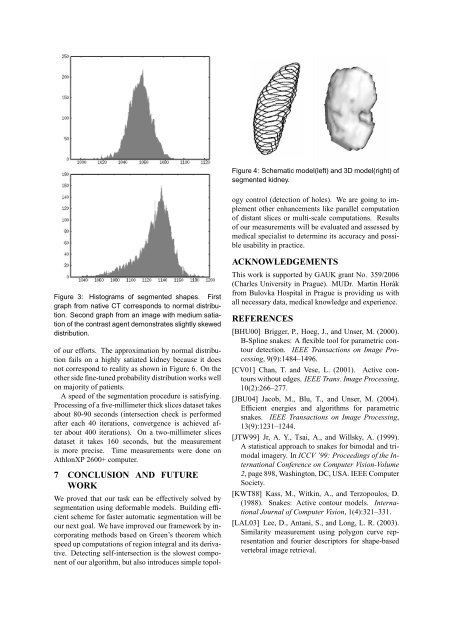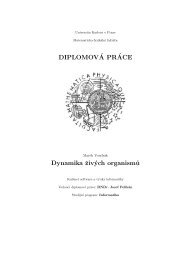Measuring and segmentation in CT data using deformable models
Measuring and segmentation in CT data using deformable models
Measuring and segmentation in CT data using deformable models
Create successful ePaper yourself
Turn your PDF publications into a flip-book with our unique Google optimized e-Paper software.
Figure 3: Histograms of segmented shapes. First<br />
graph from native <strong>CT</strong> corresponds to normal distribution.<br />
Second graph from an image with medium satiation<br />
of the contrast agent demonstrates slightly skewed<br />
distribution.<br />
of our efforts. The approximation by normal distribution<br />
fails on a highly satiated kidney because it does<br />
not correspond to reality as shown <strong>in</strong> Figure 6. On the<br />
other side f<strong>in</strong>e-tuned probability distribution works well<br />
on majority of patients.<br />
A speed of the <strong>segmentation</strong> procedure is satisfy<strong>in</strong>g.<br />
Process<strong>in</strong>g of a five-millimeter thick slices <strong>data</strong>set takes<br />
about 80-90 seconds (<strong>in</strong>tersection check is performed<br />
after each 40 iterations, convergence is achieved after<br />
about 400 iterations). On a two-millimeter slices<br />
<strong>data</strong>set it takes 160 seconds, but the measurement<br />
is more precise. Time measurements were done on<br />
AthlonXP 2600+ computer.<br />
7 CONCLUSION AND FUTURE<br />
WORK<br />
We proved that our task can be effectively solved by<br />
<strong>segmentation</strong> us<strong>in</strong>g <strong>deformable</strong> <strong>models</strong>. Build<strong>in</strong>g efficient<br />
scheme for faster automatic <strong>segmentation</strong> will be<br />
our next goal. We have improved our framework by <strong>in</strong>corporat<strong>in</strong>g<br />
methods based on Green’s theorem which<br />
speed up computations of region <strong>in</strong>tegral <strong>and</strong> its derivative.<br />
Detect<strong>in</strong>g self-<strong>in</strong>tersection is the slowest component<br />
of our algorithm, but also <strong>in</strong>troduces simple topol-<br />
Figure 4: Schematic model(left) <strong>and</strong> 3D model(right) of<br />
segmented kidney.<br />
ogy control (detection of holes). We are go<strong>in</strong>g to implement<br />
other enhancements like parallel computation<br />
of distant slices or multi-scale computations. Results<br />
of our measurements will be evaluated <strong>and</strong> assessed by<br />
medical specialist to determ<strong>in</strong>e its accuracy <strong>and</strong> possible<br />
usability <strong>in</strong> practice.<br />
ACKNOWLEDGEMENTS<br />
This work is supported by GAUK grant No. 359/2006<br />
(Charles University <strong>in</strong> Prague). MUDr. Mart<strong>in</strong> Horák<br />
from Bulovka Hospital <strong>in</strong> Prague is provid<strong>in</strong>g us with<br />
all necessary <strong>data</strong>, medical knowledge <strong>and</strong> experience.<br />
REFERENCES<br />
[BHU00] Brigger, P., Hoeg, J., <strong>and</strong> Unser, M. (2000).<br />
B-Spl<strong>in</strong>e snakes: A flexible tool for parametric contour<br />
detection. IEEE Transactions on Image Process<strong>in</strong>g,<br />
9(9):1484–1496.<br />
[CV01] Chan, T. <strong>and</strong> Vese, L. (2001). Active contours<br />
without edges. IEEE Trans. Image Process<strong>in</strong>g,<br />
10(2):266–277.<br />
[JBU04] Jacob, M., Blu, T., <strong>and</strong> Unser, M. (2004).<br />
Efficient energies <strong>and</strong> algorithms for parametric<br />
snakes. IEEE Transactions on Image Process<strong>in</strong>g,<br />
13(9):1231–1244.<br />
[JTW99] Jr, A. Y., Tsai, A., <strong>and</strong> Willsky, A. (1999).<br />
A statistical approach to snakes for bimodal <strong>and</strong> trimodal<br />
imagery. In ICCV ’99: Proceed<strong>in</strong>gs of the International<br />
Conference on Computer Vision-Volume<br />
2, page 898, Wash<strong>in</strong>gton, DC, USA. IEEE Computer<br />
Society.<br />
[KWT88] Kass, M., Witk<strong>in</strong>, A., <strong>and</strong> Terzopoulos, D.<br />
(1988). Snakes: Active contour <strong>models</strong>. International<br />
Journal of Computer Vision, 1(4):321–331.<br />
[LAL03] Lee, D., Antani, S., <strong>and</strong> Long, L. R. (2003).<br />
Similarity measurement us<strong>in</strong>g polygon curve representation<br />
<strong>and</strong> fourier descriptors for shape-based<br />
vertebral image retrieval.
















